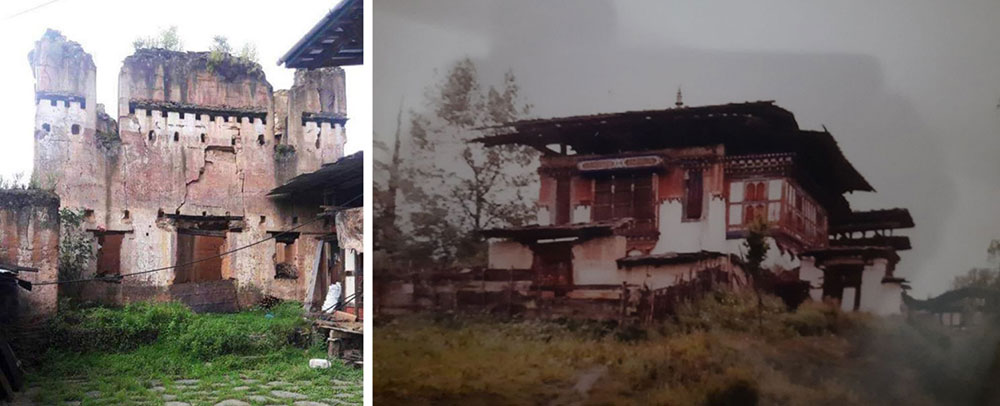The partially ruined Samtenchoeling Gonpa on the Samteling hilltop near Gyatsa village in Chumey valley in Bumthang is the dhensa (abode) of the Kuenkhen Longchen Rabjampa. Kuenkhen (meaning ‘all-knowing’ or ‘all understanding’) Longchen Rabjampa is also known as the second Buddha and was one of the greatest of all Nyingma masters of Mahayana Buddhism. He was born on the Tenth Day of the Second Month of the Earth Monkey Year of the Fifth Rabjung (1308) at Teo Drong in the Tra valley of Yuru Dra province of central Tibet.
The Samtenchoeling monastery is built on the Samteling range, below the Tharpaling Monastery. Legends say the Samteling range resembles a snake and the Gonpa is built over the heart of the snake to subdue the snake deity so that it would not harm the people of the Chumey valley below.
The Gonpa as it is today
The uphill path snakes up the ridge of the hill and reaches the southeast entrance of the Gonpa. This entrance is on the north-south axis with the northeast entrance. These two entries open into a spacious stone-paved courtyard. The Gonpa complex encloses the stone-paved courtyard on three sides, leaving it open toward the east.
On the south side of the courtyard stands the ruins of the main Gonpa; on the west side is the owners’ living room, while the northern end houses the kitchen and an open store. The edifice is a two-storey rammed mud structure built on a random rubble masonry foundation.
The main Gonpa ruins which are divided almost into two halves by a rammed mud wall has a rectangular plan measuring 11.3 x 8.5 meters enclosed with a 700mm wide mud wall completing the kora. It can be accessed with a short flight of steps from the stone-paved courtyard.
The kora leads to the south courtyard (11.3×7.4 meters), which, unlike the north one, is a small lawn. The south courtyard can also be accessed from a low doorway located at the southern end of the boundary wall. At the first-floor level (3.1 meters from the ground), it has a very wide opening.
Elderly people visiting the temple recall that three doors led into the goenkhang (inner sanctum) from the prayer hall. It is said that lam’s residence was on the first floor on the north side of the courtyard and there was a balcony connecting his residence to the Gonpa so that the Lam need not go to the ground below to enter the Gonpa and the goenkhang.
The north façade of the Gonpa had a balcony for viewing the mask dances during festivals. On the eastern side of the courtyard, people used to erect a temporary gallery during festivals. Before a fire destroyed the Gonpa in 1983, there used to be a bi-annual Samling Mani festival with Pema Lingpa’s dances, alternatively with that of Buli Mani in the neighbouring Buli Lhakhang.
Fire guts it all
As with many of the other historic places in Bhutan, the glory of Samtenchoeling Gonpa was lost due to a fire accident around 37 years ago. Natives recall the fire on the 16th Day of the 11th Month of Water Pig Year (1983) in the Bhutanese calendar.
It is said a physically disabled helper to the Samtenchoeling Lam used to live nearby. His house got damaged in a minor earthquake and he shifted his home to a temporary shed near the southeast entrance to the complex. It is said that at around 7:30 am on the fateful day, the helper started the fire in his shed to dry his boots and went out.
However, the fire spread through the shed into the south Rabsey and the entire complex. When people from the neighbouring villages reached the site, it was too late. There was no water available nearby. It would take half an hour to fetch water on horseback.
However, some of the sacred statues of Kuenkhen Longchen Rabjampa and Terton Pema Lingpa along with numerous Royal Commands as early as the 1920s were saved and kept with the owner and family. More than 37 years after the unfortunate fire accident, the partially ruined and neglected Samtenchoeling Gonpa awaits restoration and a citizen-led and government initiative to relive the legacy of its past glory. Local institutes like the Technical Training Institute at Chumey would be interested in providing the much-needed technical support in its restoration.
Contributed by Sonam Choden & Dhrubaraj Sharma


